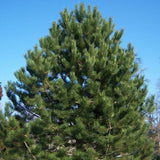Pinus monticola (Idaho White Pine, Silver Pine, Western White Pine)
Pinus monticola (Idaho White Pine, Silver Pine, Western White Pine) is a species of pine tree native to western North America, particularly in the mountainous regions of the Pacific Northwest and the Rocky Mountains.
Appearance: Western White Pine is a large evergreen tree that can grow up to 50-70 meters (165-230 feet) tall, with a straight trunk and a pyramidal crown in its youth, which becomes more rounded with age. The bark is initially smooth and grayish-brown, becoming deeply furrowed and reddish-brown on mature trees.
Leaves: The leaves of Western White Pine are needle-like and occur in bundles of five needles per fascicle (bundle). The needles are typically 5-10 centimeters (2-4 inches) long, flexible, and bluish-green. They persist for several years before shedding.
Cones: Western White Pine produces both male and female cones on the same tree. The cones are ovoid to cylindrical in shape and measure about 10-20 centimeters (4-8 inches) in length. They are typically green when young, turning brown as they mature. The cones contain winged seeds that are dispersed by wind.
Habitat: Western White Pine is typically found in montane and subalpine forests, often at elevations between 900 to 2,700 meters (3,000 to 9,000 feet) above sea level. It thrives in a variety of habitats, including mixed coniferous forests, Douglas-fir forests, and cedar-hemlock forests. It prefers well-drained soils and is often found on slopes and ridges.
Distribution: The natural range of Western White Pine extends from British Columbia in Canada, through the Pacific Northwest states of the United States (Washington, Oregon, Idaho), and into northern California. It is an important component of forest ecosystems within its range.
Ecological Importance: Western White Pine provides habitat and food for various wildlife species, including birds, mammals, and insects. The seeds are an important food source for many animals, and the dense foliage provides cover and nesting sites. Additionally, Western White Pine forests contribute to soil stabilization, water retention, and carbon sequestration.
Commercial Use: Western White Pine wood is valued for its straight grain, fine texture, and light color, making it suitable for a variety of woodworking applications, including construction lumber, furniture making, and cabinetry. It has historically been an important timber species in the Pacific Northwest.
Overall, Pinus monticola, or Western White Pine, is a large and ecologically significant tree species native to western North America. It plays a vital role in forest ecosystems and provides valuable economic and ecological benefits. Conservation efforts are important to protect and sustainably manage populations of this species in its natural habitat.
Botanical Name : Pinus monticola
Common Name : Western White Pine
Height : 165-230 ft
Spread : 80-115 ft
Germination Info : Seed require 30-45 days cold moist stratification
Hardiness zone : 4-8
Average seed per ounce : Approx. 1,200
















